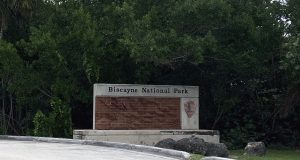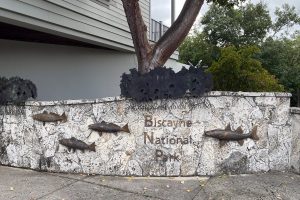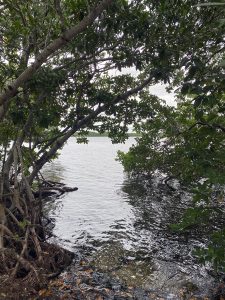
Park almost became an urbanized area
HOMESTEAD Fla. — An abundance of red, white and black mangroves twist in all directions with roots plunging into the water surrounding the Dante Fascell Visitors Center at Biscayne National Park.
Mangrove trees are the natural protection of the shoreline from hard waves, storm surges and erosion, while giving a hiding place for all types of marine life under the beautiful blue sea. Biscayne National Park, a short 30-minute drive south from Miami, is home for creatures of all sizes that scurry through the thick green vegetation and glide through the sparkly clear waters.
 |
Visitors will drive by the big stone sign at the entrance of Biscayne National Park (Photos by Isabella Popadiuk). |
While these animals live at the park full time, approximately 500,000 annual visitors come to explore the robust habitat. Each day in the South Florida climate brings new weather, presenting opportunities for different activities and outdoor adventures. Windy days attract the wind surfers and sailors, while calm days make it perfect to snorkel or paddleboard in the water.
Waves wash up to the shore, pushing algae and other marine life gently through the clear blue waters. Even on a cloudy day the vibrant colors of the green plant life shines brightly along the coastal waters. Wind rustles the trees and birds sing beautifully, complimenting the abundant nature around them, as a wide array of activities are going on as far offshore as the eye can see.
Kayakers gather eagerly in a circle around a ranger on land, awaiting to enter the waters and learning the intricacies and safety techniques before paddling out to explore. Snorkelers dive and eventually sink into the water from their boats, becoming part of the spectacular coral reefs below with its vibrant ecosystem of life.
Maya Van Scoyoc, a 20-year-old University of Miami student, visited Biscayne National Park for the first time in December 2021. She adored the quiet and peaceful energy lingering around the park, and the wide expenses of water terrain.
“It’s an escape for people who live in the city, like Miami, who want to feel like they’re away on vacation and get away from the loud busy city life to a very relaxing peaceful area,” Van Scoyoc said.
The real secret treasures of Biscayne National Park can be found only a boat ride away offshore, to the beautiful islands and keys. Biscayne is the largest marine park in the national park system, housing miles of coral reef ecosystem communities and their animal inhabitants.
Coral reefs around the world, like the one at Biscayne National Park, face threats of climate change, like rising sea temperatures and atmospheric conditions, which result in possible coral bleaching and dying out. Many years ago, these ecosystems in South Florida were in peril of not being protected at all, but by government involvement today they are being supported.
Conservationists in the 1960s fought hard against developers to protect the vast marine, plant and animal life that is Biscayne National Park. If it weren’t for their efforts and recognition of this special area, the land that the park lies on today would have been redeveloped with hotels and large residential communities taking over.
South Florida as we know it would be substantially different without the expanded growth and protection of Biscayne National Park.
The region has a rich history, including being inhabited with various cultures for thousands of years. The National Park Foundation is one of the nation’s resources for park goers across the country to learn, educate and inform the public on all things related to our national parks. Their mission hopes to achieve protection of not only the national parks and the wildlife, but also the history and culture fostered uniquely within each one.
According to The National Park Foundation online presentation about Biscayne National Park, the appeal is the environment and its rich human history.
“While Biscayne National Park was established primarily for its natural features, it also preserves and tells the story of human history over 10,000 years. Nearly every island in the park has evidence of use by native peoples and below the water’s surface are the remains of many shipwrecks,” officials at the foundation argue.
| The entrance from the parking lot for the Dante Fascell Visitors Center. The center has great resources for visitors to learn more about the park. |  |
Tequesta, a Native American tribe, is believed to be the first inhabitants of Biscayne’s islands, according to park historians and the visitor center exhibition area at Biscayne National Park. The Biscayne National Park visitors center exhibits a small yet entirely immersive experience covering the vast history of this territory.
Figurines of numerous plant and animal species found throughout the park are enclosed in glass cases showcasing diversity, and it is truly spectacular to witness a near identical version of the species someone might not have an opportunity to see during their park visit.
In the exhibit, the colorful fish figurines crowd the glass tanks, but it does not do the majestic creatures justice under the sea. Thus, the park is a main destination for snorkeling and scuba diving. Besides sea animals, another attraction for those who love the water is the shipwrecks scattered below the blue waters of Biscayne National Park.
This vast mariner history is rooted in hundreds of years, as sailors attempted to navigate their masted ships through dangerous and threatening waters, many were unsuccessful eventually wrecking on the reefs. Currently there are more than 50 documented shipwrecks in the park, a favorite of treasure hunters and shipwreck seekers.
“Pirate ships from Spain, France and the Netherlands came to Florida in the 16th century. Legends tell of Black Caesar who took shelter near Adams Key and ambushed ships as they approached the shallow reefs,” according to Biscayne Park historians.
The area of Biscayne National Park has a very plush and exclusive history for the past hundred or so years involving wealthy and renowned property owners. At one point some islands and keys were owned by prominent and successful people to be used as vacation homes and future developments. For example, millionaire Mark Honeywell built the famous lighthouse on his private island of Boca Chita Key in 1938.
In the 1920s, Florida became a popular destination for travelers, causing property values around South Florida and the keys to increase drastically. As the years passed, people had different ideas for how to use the land of what now is Biscayne National Park. The two opposing sides: those in favor of development and those in favor of habitat and ecosystem conservation.
The conservationists prevailed after a tough but meaningful fight. In Congress, South Florida Rep. Dante Fascell led the efforts to create Biscayne National Monument to protect the area. President Lyndon B. Johnson signed the bill on Oct. 18, 1968. In 1980, the park was upgraded to national park status. From there on the park continued to grow into the area we recognize today.
The bottom line is Biscayne National Park holds a massive amount of history and culture from people all over the world to become the national treasure and bountiful ecosystem it is today. But the park would not have made it without the conservationists in the 1960s and park rangers who contributed to the success and expansion of the park.
 |
Mangroves and vegetation surround the shoreline of Biscayne National Park. |
Biscayne National Park celebrated its 50th official anniversary in 2018.
Gary Bremen has been an interpretive ranger at Biscayne National Park for nearly 30 years. His main role as a ranger is education, outreach, events and media related activities. He has worked at numerous different national parks and currently still works around the country on short term assignments.
“It was kind of a sleepy-ish place that a lot of people didn’t know about. And there were lots of folks who would go to other national parks in South Florida. And this one never seemed to be on their radar. Ever since the centennial of the National Park Service in 2016, so many people are out to try and visit all the national parks, whether they count just 63 of them or all 423 of them. You know, people are trying to collect them all. So, we have good visitation numbers. We get about a half million visitors per year at our visitor center and out in the park and the waters out there,” said the ranger.
Despite Biscayne National Park being a protected area, it still faces many threats. Many factors threaten the park’s natural ecosystem and species, such as climate change, increased use of plastic, pesticides and much more.
As said by Bremen and other historians, some of these species rely on the park for the entire species to survive such as the Schaus swallowtail butterfly.
The National Park Foundation, the only Congressionally mandated fundraising organization in support of the National Park Service, stated, “Biscayne National Park protects four distinct ecosystems, all which work together to create a precious habitat for over 20 threatened or endangered species.”
One of the most crucial but delicate aspects of the park’s ecosystem are the coral reefs. Reefs need very precise conditions to live and flourish. Even slight temperature changes can cause coral bleaching when algae leaves a coral to find a better place to live.
“I’ve seen a decline in coral reefs and their vibrancy. We’ve seen a big increase in the amount of marine debris that washes in on shorelines,” commented Bremen.
“But things that have remained the same or you know that it’s still my favorite place in the world. So, despite all those things, it’s got its challenges for sure, being so close to a major urban area, but still an amazing place
Bremen’s biggest suggestion for how visitors can help preserve the park is simply to take care of your own stuff and not forgetting or neglecting trash, especially on the islands where they do not have a trash collection system because of cost and complicated strategies. He says it is important to recognize the idea that national parks are to be a place that belongs to everyone, so everyone is responsible for taking care of it and making sure it lasts.
“The reason people come to Biscayne National Park is because it is a beautiful place and if you don’t treat it properly, it’s not going to be a beautiful place anymore,” he said.
The future of Biscayne National Park is in our hands, park officials will remind us, especially those who live in South Florida. Respecting and taking care of our national parks will ensure parks like Biscayne stay thriving for years to come and future generations.
If You Go
- Address: Dante Fascell Visitors Center, 9700 SW 328th St., Homestead, Fla. 33033.
- Phone: Information Desk 305-230-1144.
- Web site: https://www.nps.gov/bisc/index.htm.
- Hours: Visitor Center, everyday 9 a.m. – 5 p.m., park water hours, every day, 24 hours a day.
- Fees: Parking and entrance to the park is free.
- Facilities: Ramps, elevators and boardwalks at the visitor center. Access beyond the mainland shoreline requires a boat.
- Activities through the park: Boating tours, snorkeling, camping, junior park ranger program, paddle boarding and canoeing tours.
- Activities on your own: Boating, scuba diving, wildlife watching.

Comments are Closed